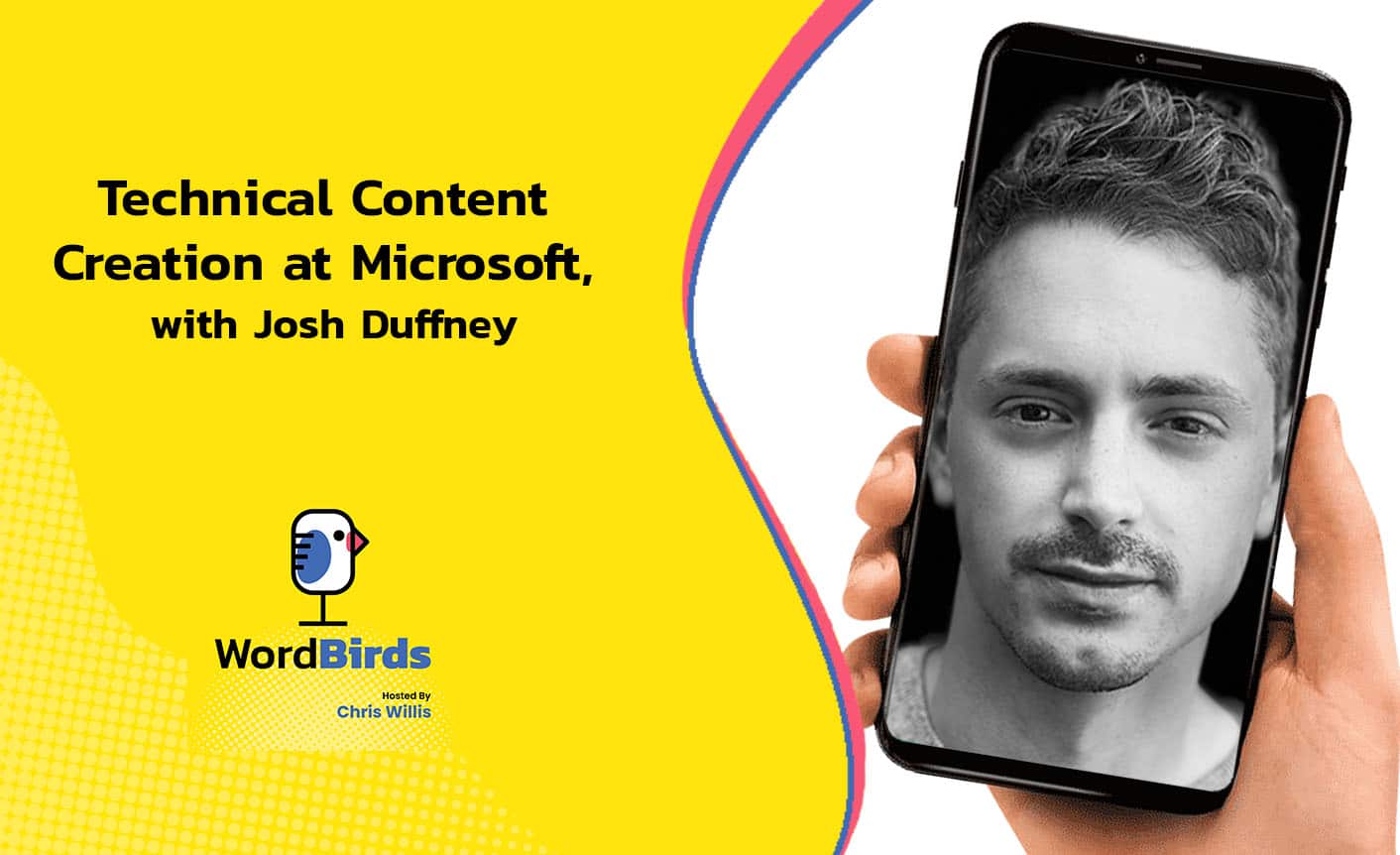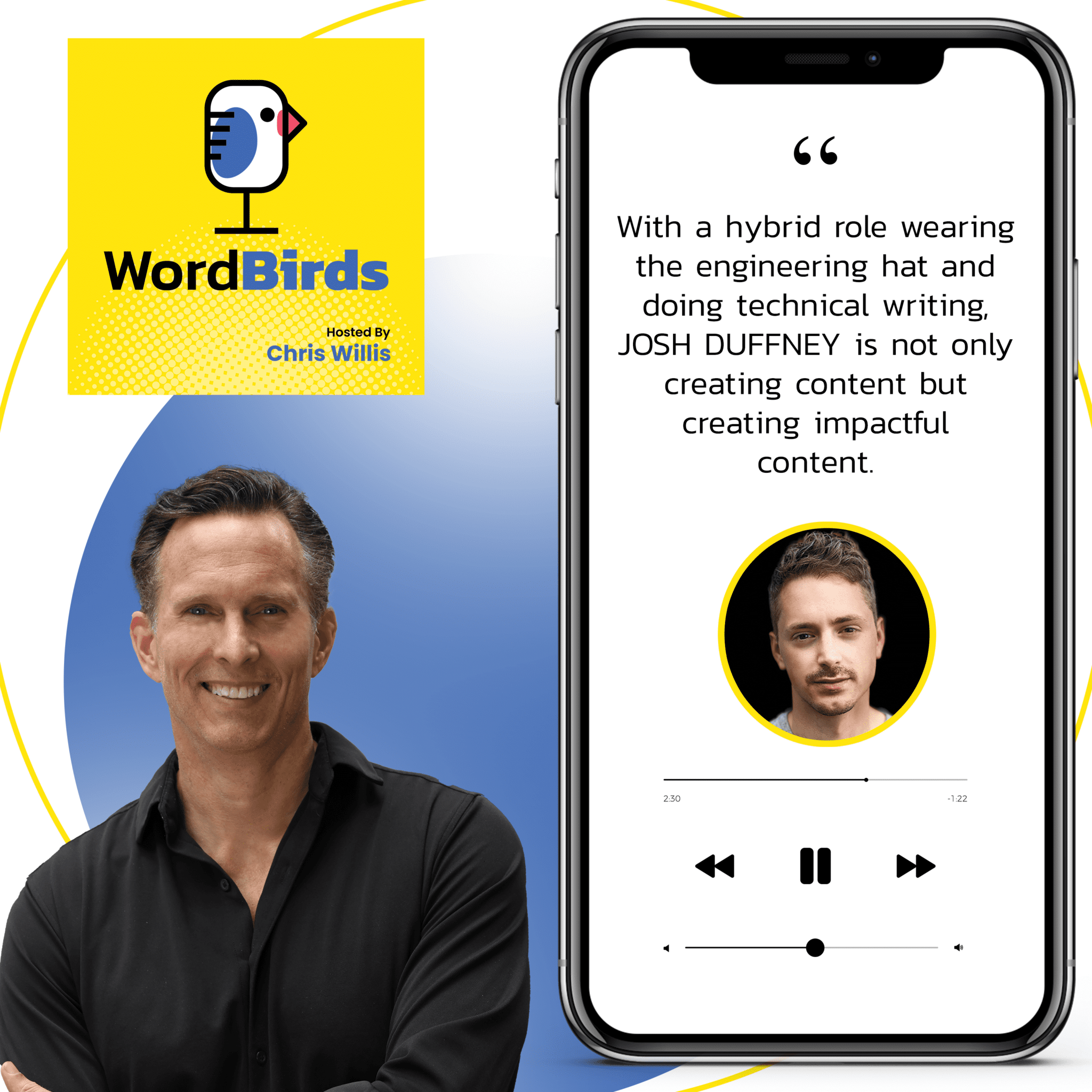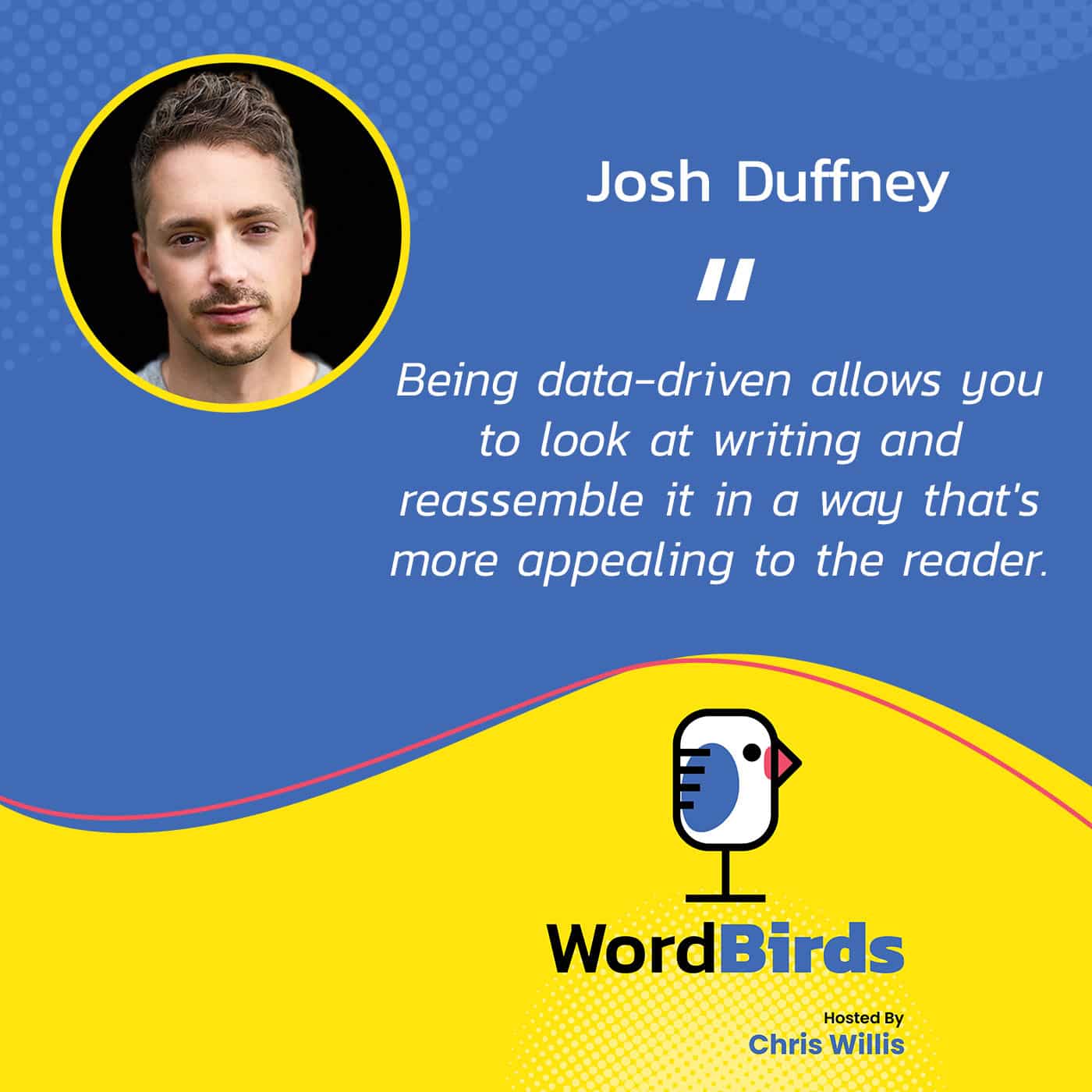
No matter where we are, our passions will manage to find us. Josh Duffney’s love of words and writing took him from his role as a software engineer to technical content creation at Microsoft.
In this episode, he joins Chris Willis to share with us that evolution and how he is now working in a hybrid role between engineering and writing. Josh shares the value of feedback in his writing process and what he sees in the creation of impactful content. Follow Josh in this conversation and dive into the world of technical writing!
Watch the Episode here
Listen to the podcast here
Read full episode transcript
Now on the show, we have a guy named Josh Duffney, who is here to talk to us about the evolution from his role as a software engineer to where he is now in content creation within Microsoft. We are going to talk about that love of words and writing that helped propel his career into technical documentation and now a hybrid role where he is both involved with engineering and writing. Let’s sit back and get some insight from the flock.
Josh, welcome to the show.
Thank you so much for having me. It is a pleasure to be here.
I’m excited about having you here because the transition that you have made in your career is interesting. We are talking to a guy that has been a DevOps engineer. You have worked at several companies. Somewhere along the way, you added content creation as a side gig. You are working at places like Pluralsight and CloudSkills. You reference leaving what you thought was your dream job to try something completely different. That is enough with the teaser. Tell me a little bit about you, where you were, and where you got to.
If we go to a quick summary going all the way back, I thought I wanted to be a video game designer. I got the pressure and the six-figure price tag attached to that. I said, “No, I don’t want to go immediately into six figures of debt.” I joined a charter school. I got two years of education for free at a local community college and graduated with my Associate’s degree in Computer Networking.
It broadened my awareness of what computing was and what it was to work in technology. That was enough to get my foot in the door to the help desk. I moved into a help desk role there. This is where the content creation got the seed for it and got started. I was part of this help desk tool. My first project was to create a help desk tour to install it. People could submit tickets. I could respond to those tickets, solve issues, install printers, and so forth.
It was called Spiceworks and had this community aspect to it where I was a one-man shop. My boss is a firefighter. He knew all the things but he was only there a couple of days out of the week. For the other days, I was completely solo but I had this community where I could ask questions. I started to ask questions online and get detailed answers that made me look good in my boss’s eyes and my boss’s boss’s eyes when I was performing well.
Eventually, I got a feeling I should contribute back to this community. I have taken so much for it. I started to answer questions and write how-tos. It morphed into a blog later on. I got into the Pluralsight content and the CloudSkills content. I’m being recognized as an expert in a particular space for technology, and that grew and grew.
In the area where I had spent several years, I felt like I needed to share my learnings from it. I went to Pluralsight, and they were like, “We don’t have any slots available for that type of content. Someone has already done it. I know you want to do it a little bit differently but we don’t have it in our catalog now.” I sat back and thought, “I always wanted to write a book. Why don’t I write a book?” That’s when I started that.

That act of creating that book on the side was what pushed me to put down my pager because I had been in IT operations for about a decade and switched full-time to technical writing. That was the pivotal moment when I wrote the book. I enjoyed the writing and sharing in that aspect and the whole creative process around that. I have decided to dive a little bit deeper into that as a career prospect.
For people that don’t know, that is on note-taking in Obsidian.
That is the second one. The first one was to become Ansible. That is around a technology called Ansible. Infrastructure is code DevOp, and it is very technical. As I wrapped it up, I had in my mind a non-fiction book that I wanted to write that I was like afraid to write first. I figured I needed to start my comfort zone, and that is why I started with become Ansible. As I was trying to figure out how to write non-fiction, I became obsessed with note-taking and wrote that book that you referenced, How to Take Smart Notes in Obsidian. It has been compounding since then.
The take that we have is that content isn’t relegated to writing teams anymore. Everybody is a content creator. Whatever you do, you walk into your job and create things that are used by-products of which are used as content for your organization. You have made that full shift into that new area. People can read more about this on your blog. It’s not io but moving beyond that article, where did that end up? At that time, you had made the shift from Stack Overflow to Microsoft in their technical documentation team. What happened when you got there?
I was in my comfort zone for several months, where I was writing about everything that I had spent a decade refining, Terraform, Ansible infrastructures code, and DevOp space. I’m refining that space on their public site Docs.Microsoft.com. I’m trying to create a good story and narrative. I have improved the documentation space there.
I was comfortable there because I could lean on my past experiences, and I didn’t get that full experience of having to be a full-time writer where you don’t know what it is that you are about to write well. That elasticity that a writer needs to skill up quickly or to learn, research, and absorb. I started to learn how to do that several months in when an opportunity came up to completely switch domain subjects.
The groups of writers are focused around particular products like Azure. In their cloud platform, you can’t know all of it as a writer. You might be able to know a service or a language. In this instance, the opportunity came up to learn Go Lang or to be the writer of that particular story on the platform. I didn’t know the language. It had been the lower-level language for some of the tools that I had used, like Terraform. I knew things that were written in it. I knew that I wanted to learn it but I didn’t know it. I also didn’t know how it would translate to the job.
I switched several into that role and got to figure out the meta-skills that a writer needs to be able to read better, be able to do research, take notes, dive deeper, and create your own progress bar. On the engineering side, problems are hitting you in the face left and right that you have to solve and reverse engineer.

That is part of the job. To have that script flipped on me where it’s like, “I have to go and find my own problems, research, and audience. Learn about what they would be doing with it and learn the language itself so I can be able to communicate that.” Learning from a writing perspective has a different lens. That is where I fail. I came into the role in full swing and got to experience what it was to be a technical writer and make that full transition from field to writing.
The interesting thing is that as software development accelerates from traditional waterfall to agile to continuous integration to continuous deployment, the thing that doesn’t change a lot is documentation creation. Writing is writing. All the things that you mentioned about having to learn, evolve, and turn something into words that are actionable and usable take time. I wonder, moving from a world where there is that constant increase in velocity, how are you keeping up with the pace of the enterprise?
The switch to writing was uncomfortable in a lot of ways because there is an acknowledgment that that takes time. You have a great degree of autonomy. The pressure like all that responsibility to manage your time is on you. Battling back meetings, finding time for work, for research, for writing itself, and breaking down that process so it is more palatable when you stare at a blank screen.
To answer your question more directly, learning what it meant to manage my time was how I fought against the velocity. How I did that was I detached from it. I pulled myself out of that world, shut myself off, made sure that I had a good statement of work, and started to break that down and modularize the work. Now, I’m researching. Tomorrow, I’m outlining.
Sometimes writing is non-linear. I have to bounce between. What always kept me focused was time blocking. I’m taking large chunks of my time and blocking them off. I can do that creative work and would scope it, so we could be manageable on a given day and also try and still be collaborative when I need to be. If I were constantly engaged in all the communication tools, meetings and discussions, I wouldn’t ever get to the creative process. Fighting for my time is how I most effectively was able to maintain that.
Time blocking keeps you focused. Taking large chunks of your time and blocking them off helps you do creative work. Share on XIt’s a real engineering view of the creative process. I wouldn’t hear a marketing person explain their content marketing creation process the way that you explained your technical content creation.
It was a great exercise because the best skillset that I got from the engineering field was the ability to reverse engineer. Looking at a particular thing, breaking it down into its elements, and creating a system around that is the only way that my mind operates. It took a lot of tinkering but I eventually got to a study process.
How much of the evolution that you made as a technical writer came from feedback from your audiences?
The writing did. Being on that large of a platform, you’ve got a lot more data points. I never looked at any of the metrics of my blog but the tooling and stuff that was around. Around the writing helped me to be like, “They are bouncing out right away. I need to write a more engaging lead. I’m putting too much context upfront.”
I got to learn through the data. A big shift for me as I get to see actual data here and not style guides, like, “Do this here, make sure the H2 is bolded or whatever,” the style guides might be. The data was telling me that I needed to do something different and change. That helped me to create an internal dialogue. It is funny now that people know that I’m in that role, they will ask me to proof, even things like an email, and I’m like, “You should move this around here. You should bold this.” I’m stumbling to find the word for that particular thing but being able to look at writing and reassemble it in a way that is more appealing to the reader. All that is coming from data and being data-driven in that has helped.

The vast volume of data was helpful. I couldn’t interview them. I wasn’t doing user studies but the next thing close would be like, “Where did they click? Where did they dwell? Where did they engage? Where did they bounce?” Being able to interpret the quality of my writing based on that was how I engaged with them the most.
From a deeper level of what content they need. It is just an online community. I involved myself in those spaces as one of them an engineer and developer in those spaces. I got to see their pain points and stuff like that by being in the conversations, and the online forms and Slack channels were the two ways that I engaged with them and used their feedback to improve my writing.
You are describing the evolution between content intelligence and content impact. The idea of being able to create a piece of content that is designed from the get-go predictively to create the impact that you are aiming for. If it doesn’t, looking at the components of that content and understand why in iterating.
There is a style guideline like you said but there is a tone of voice, talking about Microsoft, global terminology directory, and educational level of the people that are going to be reading your content, clarity, overall consistency of that, inclusive language, and all of the things that come together to create the piece of content that you are delivering. There is a mix to that in any given piece.
You launch that piece of content. Look at how it performs. What is the bounce rate? How much time is being spent there? What is the intended end result? Is it a conversion? Is it a click? Is it something? If you are not seeing it, how do you overlay that disconnect on top of your existing content and make it more impactful?
To us now in the market, that is the thing that is becoming the most important because, in everything that you are creating, there is a cost. They pay people like you to create content. They pay people to edit that content. They have legal to review that. There is this creation cost associated with content but that is not the end of it because anything that we create has to be put out in the world. You got either a push or a pull.
From a push standpoint, I’m going to be paying for the syndication of that content. I’m going to be paying for the advertising of that content, whatever it might be. On the pull side, am I going to be found? I’m paying SEO, social, and any number of things to make sure that the content is found there. This compounding cost associated with it, is it going to solve the expected problem? Is it impactful? You did a good job of explaining exactly how you were seeing the creation of impactful content from your side.
I would add another interesting thing that I observed is a shift, for the lack of a better analogy like the newspaper stand. It is about volume and volume out because now the volume out has a high cost associated with maintenance. Now, it is more of a focus on what you are describing there. I’m making sure the content hits and lands. If it doesn’t, we need to eat the cost and take it down because we need a leaner content set for both content sets because all of that is going to be a dead weight. There is a lot of dead weight and content now, it seems.
At least on the marketing side, 50% of enterprise content ends up going unused largely, though, because of the amount of time it takes to create it. I want something and order it. Content marketing sources that are either internally or externally. Some subject matter expert creates it. It goes to review. The editorial takes over. There is that back and forth. It comes back to the stakeholder, somebody like me, and I’m like, “This is what I was looking for, but what if we did a little bit of something different here.” We are back to the beginning of this process. Finally, it made it back to me. I’m happy with it. I’m like, “Did legal look at this?” We are back to it.
Content in an enterprise environment generally takes between six and eight weeks to make it through this full process. If it was something timely, I don’t need it anymore. Thanks very much. We spent a lot of money, time, and resources to create something that goes into a repository and creates risk going forward because now it’s going to time out. Nobody is ever going to maintain it, and somebody is going to pull it out in three years, go and put it in front of a customer. The best case is that it is just old. The worst case is that we are out of compliance. We are breaking a regulation. Something is happening, and now we are all going to get fined.
It is interesting to think about the velocity of this process and align it with this lean environment where I don’t have that cost. If you look at Docs.Microsoft.com, millions of pages of content is a multibillion-dollar asset, and nobody thinks about the cost because nobody has it as a budget item. It is a thing that people do when they go to work, and you are part of that. Moving forward from the article to the experience in technical writing, you have evolved into a cloud advocate role. What is that?
It is a different type of developer advocate. It is a developer who advocates on behalf of a company for a particular technology. It is similar to what I had done in my previous life but not being paid full-time for it. Creating content, creating open-source projects, engaging with the community, and being the shim between the customer and the product team is my primary objective. What my daily duties look like is a 50/50 blend of what I used to do in my previous two roles.
A cloud advocate is a developer who advocates on behalf of a company for a particular technology. Share on XFifty percent of my time is typically projects and engineering-focused. Those are community-driven. Open source projects that are more around developer productivity and experience. I’m creating tooling that helps to better rap, abstract or simplify a particular toolchain. The rest of it is around content, whether internal or external, between the customer or the development team itself.
The people that are creating the products inside Microsoft are being consumed by a customer. I get to be that intermediary resource that gets to both tinkers with the technology. I still wear the engineering hat but am also still responsible for creating content that has an impact. It is not necessarily all written content because I was primarily a docs writer before, and writing content was my full-time gig.
That medium has changed where the video is included in there. I can do conference talks. I can do blog posts or formal tutorials or GitHub repository READMEs. I have a lot of different mediums at my disposal to express the content or the learning, which is interesting. All of that stuff that we had talked about is how do we make sure that the content is engaging and leads transfer over into thumbnails and all that good stuff. There is a lot of transfer in the new role. The next evolution is a step back into a world of both that I used to do, and I’m enjoying it so far.
It feels like you are three-quarters around the traffic circle. There is a pathway where you make it all the way back to what you were doing at the beginning and make it back to engineering but there is also an off-ramp here where you become a Twitch streamer and do all kinds of interesting and creative. I look at all of the things that you mentioned as content. Content is a tricky word because people think of it as a lot of different things but it seems like in the enterprise, it is come to mean in writing.
This is content, your video, YouTube channels, chatbots, and all of it leverages content. It all comes from the same place. It all requires that same rigor to make sure that it is achieving its end goal. This is an interesting space for anybody to be playing in. You are playing in an interesting company. You couldn’t be in a better place right now. Based on your blog, I would assume you must be making at least $500,000 a year doing this based on how you left your $500,000 job.
That is not quite there yet.
You are going to have to visit Duffney.io to understand what we are talking about. It is an article. You can read it. This has been great. I’m excited to see what comes next for you. If people want to get in touch to follow up on this conversation and see where you are going, what is the best way to follow you?
The best way to follow me or to reach me is on Twitter, @JoshDuffney. From there, there are links to my blog newsletter, YouTube channel, and stuff. Twitter is the best place to find me.
Josh, thanks for being on the show. I’m sure everybody is going to enjoy this, and you can expect that lots of people will follow you as a result. Hopefully, we will get you back on here in the future.
Please do. It was my pleasure, and thank you so much for having me.
Thank you very much.
Important Links
- Microsoft
- Josh Duffney
- Pluralsight
- CloudSkills
- Spiceworks
- Obsidian
- Ansible
- How to Take Smart Notes in Obsidian
- Stack Overflow
- Terraform
- Docs.Microsoft.com
- Azure
- Go Lang
- GitHub
- @JoshDuffney – Twitter
- YouTube – Josh Duffney
- WordBirds – LinkedIn
- WordBirds – Home page
About Josh Duffney

Josh Duffney is the author of Become Ansible and How to Take Smart Notes in Obsidian. He works at Microsoft as a technical writer and enjoys building systems of productivity that enable him to balance work, life, and his creative pursuits.
Are you ready to create more content faster?
Schedule a demo to see how content governance and AI guardrails will drastically improve content quality, compliance, and efficiency.
The Acrolinx Team




